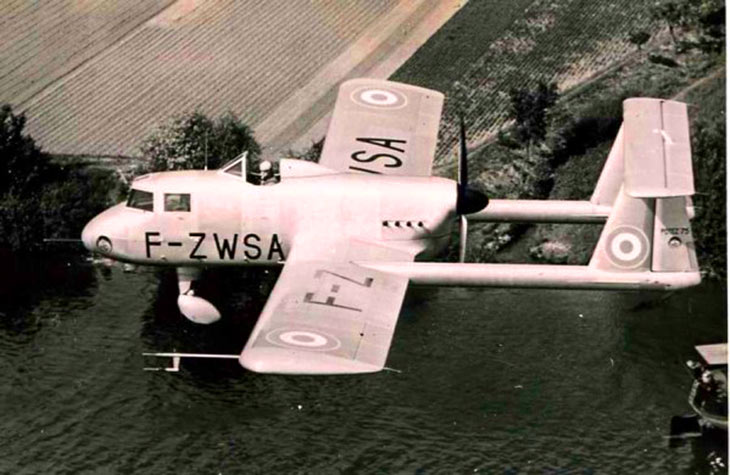Potez
75 "Tank Destroyer"
The Potez 75 was a prototype French aircraft designed with the
specific role to act as a launch platform for the Nord SS.10 wire
guided antitank missile.
The Potez 75 was designed to be rugged, easy to maintain, simple to
fly, and able to operate from short and/or bumpy makeshift landing
strips. It was envisaged that the aircraft would fight closely alongside
French armored units, and the aircraft was even fitted with a standard
French tank radio system so the pilot and gunner could communicate
directly with the soldiers on the ground.
The first prototype was built in just five months, and the Potez 75
flew for the first time on 10 June 1953. The crew of two were seated
in an unusual configuration, with the pilot sitting in an open cockpit
above the fuselage, while the gunner sat in the enclosed nosecone.
Both the pilot and gunner were protected by armor plating to provide
some degree of cover from ground fire.

The Potez 75 was a fairly simple and uncomplicated aircraft. It featured
a fixed tricycle undercarriage, a pusher propeller and a twin-boom
tail with a high-mounted horizontal stabilizer. The engine was a inverted
V8 air-cooled unit which provided 480 horsepower.
Pilots who flew the aircraft were impressed with its handling, especially
at the low altitudes it was designed to operate in. It had a low top
speed of just 171 mph (275 km/h), but it provided a stable yet responsive
platform to fire its ordinance at its intended ground targets.
During evaluation of the aircraft, the original armament of wire guided
missiles was complemented by 8 unguided rockets, while the single
forward facing .50 caliber machine gun was replaced with four 7.5
mm guns. Around the same time the pilots open cockpit was modified
with an enclosed canopy, and the gunner's position was also redesigned
to accommodate additional glazing for better vision.
After weapons testing at Cazeux, the Potez 75 was sent to North Africa,
specifically Algeria, which at the time was still a French colony.
It was modified further still and the guided missiles were removed
and the prototype aircraft was reassigned from the tank destroyer
role to the light ground attack role. Unusually for a prototype aircraft
it may even have taken part in limited combat operations during the
Algerian War (1954 - 1962).
During operational testing in 1956, an order for 15 pre-production
and 100 production aircraft was placed. However in 1957, before any
of these aircraft were built, the order was canceled. In addition
to budget cuts, one of the primary reason for the cancellation of
what was shaping up to be an effective ground attack aircraft was
the arrival of the helicopter into the French military arsenal. Attack
helicopters could fulfill all the intended duties of the Potez 75
without requiring a landing strip, and with the added bonus that it
was even more maneuverable and able to hug the landscape even better
as it stalked its targets.
In the end the sole Potez 75 built was used as a liaison aircraft
by the French military up until a crash landing in 1958 rendered it
unflyable and it was scrapped.
|

